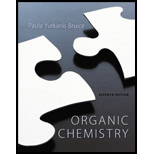
Concept explainers
(a)
Interpretation:
The products formed from the solvolysis of given compound in ethanol has to be drawn.
Concept Introduction:
Unimolecular nucleophilic substitution reaction in which the reversible ionization of
(b)
Interpretation:
The products formed from the solvolysis of given compound in ethanol has to be drawn.
Concept Introduction:
Unimolecular nucleophilic substitution reaction in which the reversible ionization of alkyl halide in the presence of aqueous acetone or an aqueous ethyl alcohol provides a carbocation as an intermediate, attacked by the nucleophile to form the product. If the leaving group in SN1 reaction is attached to the asymmetric carbon, a pair of enantiomers will be formed. An enantiomer, also known as an optical isomer, is one of two stereoisomers that are mirror images of each other that are non-superimposable.
(c)
Interpretation:
The products formed from the solvolysis of each following compounds in ethanol is to be drawn.
Concept Introduction:
Unimolecular nucleophilic substitution reaction in which the reversible ionization of alkyl halide in the presence of aqueous acetone or an aqueous ethyl alcohol provides a carbocation as an intermediate, attacked by the nucleophile to form the product. If the leaving group in SN1 reaction is attached to the asymmetric carbon, a pair of enantiomers will be formed.
An enantiomer, also known as an optical isomer, is one of two stereoisomers that are mirror images of each other that are non-superimposable.
Want to see the full answer?
Check out a sample textbook solution
Chapter 9 Solutions
Organic Chemistry; Modified MasteringChemistry with Pearson eText -- ValuePack Access Card; Study Guide and Student Solutions Manual for Organic Chemistry, Books a la Carte Edition (7th Edition)
- When propene reacts with gaseous hydrogen bromide, HBr, two products, 1-bromopropane and 2-bromopropane are formed. The reaction is a two-step process in which the electrophilic attack occurs in the first step. Identify the electrophile in this reaction Draw a diagram showing the first step of the reaction that leads to the production of 2-bromopropane.arrow_forwardWhat is the major product obtained from the acid-catalyzed hydration of each of the following alkenes?arrow_forwardWhat products are obtained from metathesis of each of the following alkenes?arrow_forward
